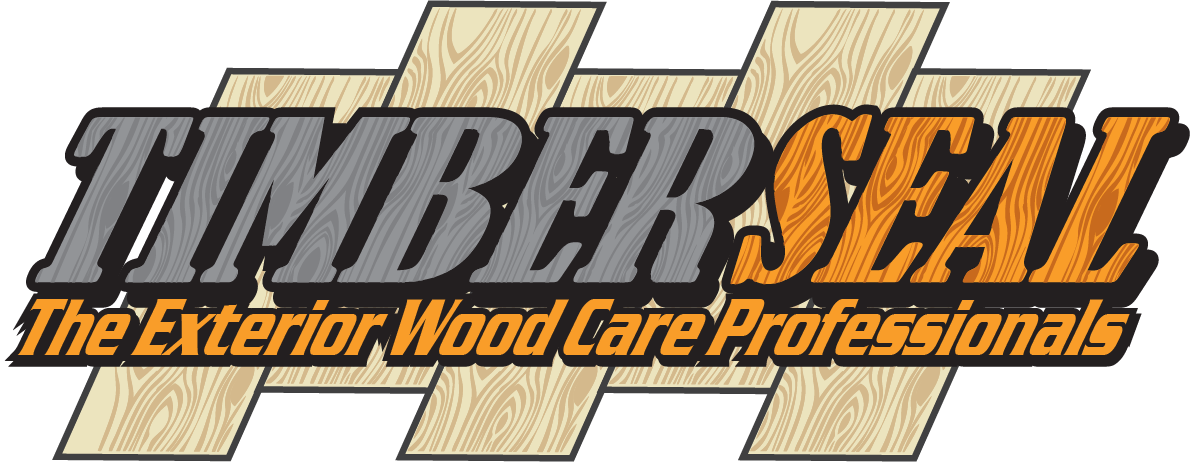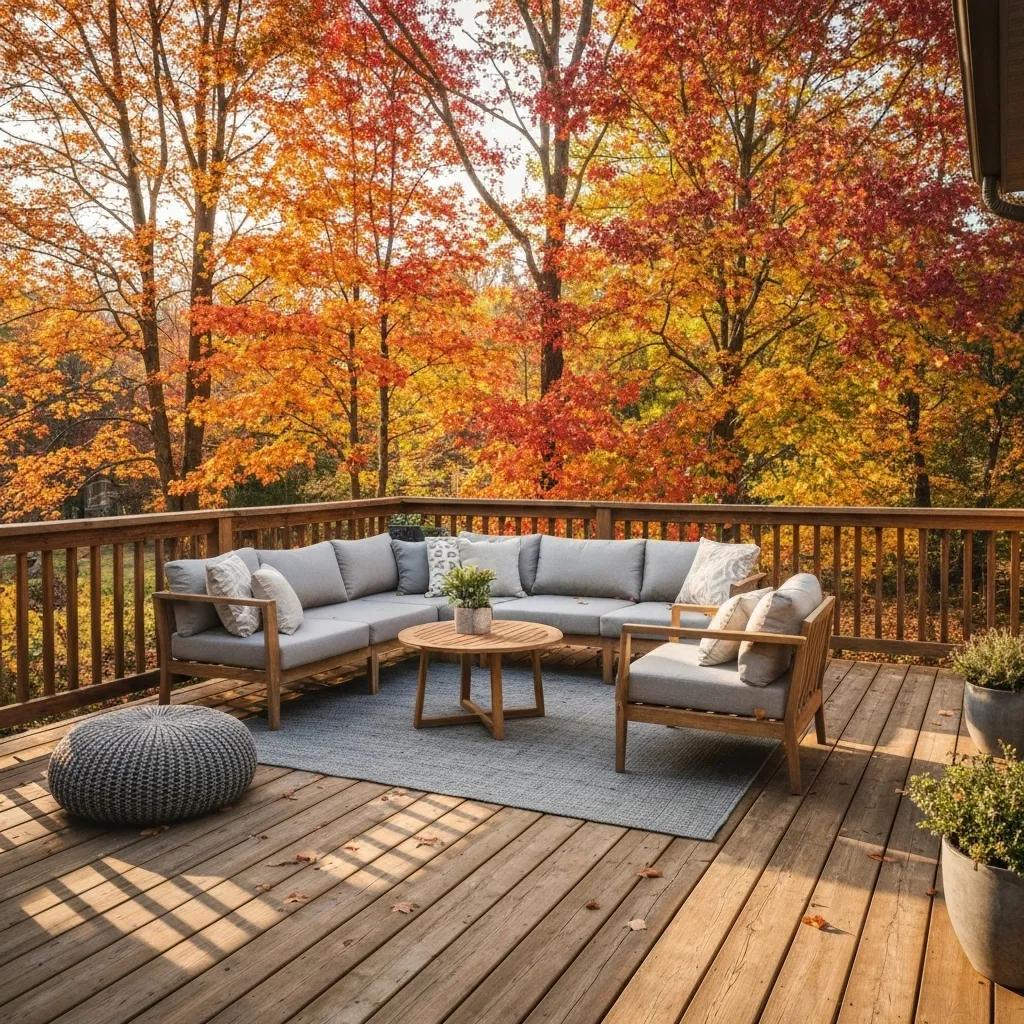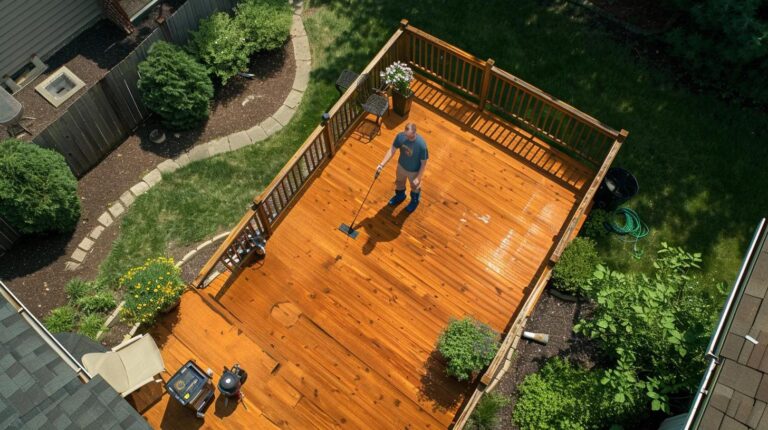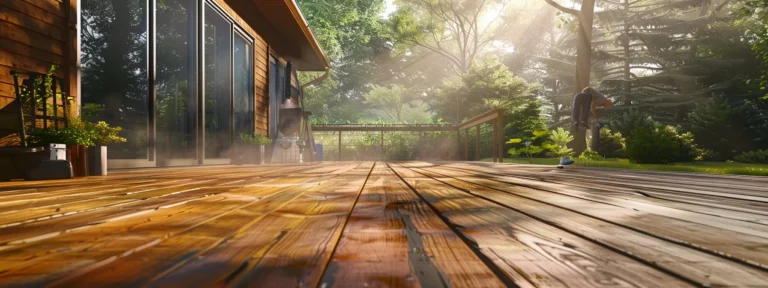Fall Deck Revival: TimberSeal’s Expert Guide to Pre-Winter Wood Restoration in Valparaiso
As Valparaiso’s crisp autumn air signals the approach of snow and ice, homeowners face a critical window for pre-winter deck care. Effective Fall Deck Revival extends your deck’s life, prevents costly repairs, and preserves curb appeal. This guide by TimberSeal Inc.—with nearly 30 years of wood restoration expertise—outlines why pre-winter wood restoration is essential, details our three-step deck revival process (soft wash cleaning, wood repair, staining & sealing), highlights local benefits, and provides a complete maintenance checklist. By following these proven methods, you’ll protect your investment and enter winter with confidence.
Why Is Pre-Winter Wood Restoration Essential for Valparaiso Decks?
Proper pre-winter wood restoration prevents moisture penetration, freeze-thaw damage, and mold growth that compromise deck safety and longevity.
What Are the Unique Winter Challenges in the Great Lakes Region?
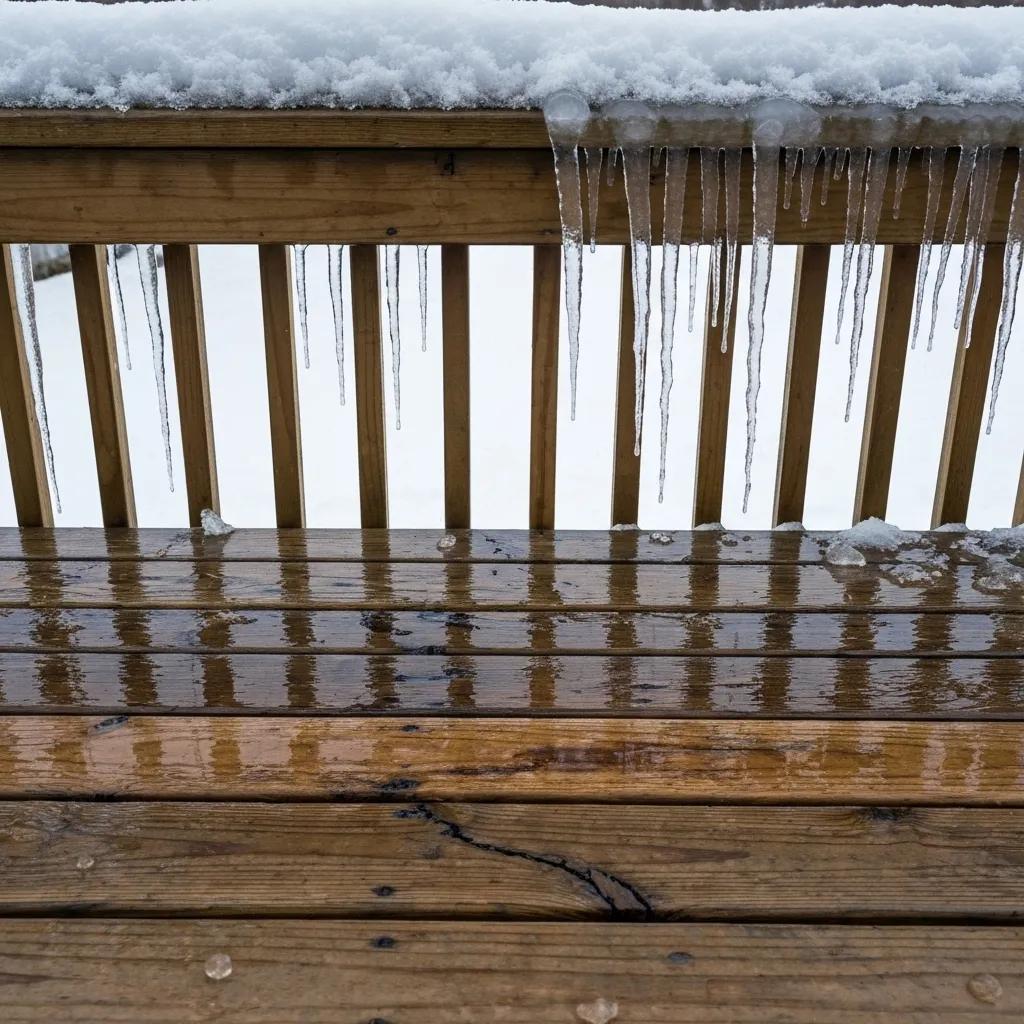
Valparaiso’s Great Lakes climate combines heavy snowfall, frequent freeze-thaw cycles, and intense UV reflection off ice.
- Freeze-thaw cycling subjects wood to expansion and contraction that leads to cracking.
- Persistent moisture from snow accumulation accelerates rot and mildew.
- Winter sun glare intensifies UV degradation on unprotected surfaces.
These challenges demand fall restoration to reinforce wood fibers before damage compounds.
The Impact of Freeze-Thaw Cycles on Wood
Freeze-thaw cycles can cause significant damage to wood, leading to cracking and accelerated deterioration. The expansion and contraction of water within the wood fibers during freezing and thawing create internal stresses that can compromise the wood’s structural integrity over time.
Which Common Wood Damages Occur During Indiana Winters?
Indiana winters often cause:
- Rot development as trapped moisture breaks down wood fibers.
- Surface cracking from repeated ice formation in pores.
- Board warping when uneven moisture leads to structural twisting.
- Mildew and mold colonization in damp, shaded areas.
Identifying these issues early enables targeted restoration before growth and deterioration accelerate.
How Does Winter Weather Impact Deck Longevity and Safety?
Winter conditions undermine deck integrity by:
- Allowing water infiltration that freezes and fractures boards.
- Promoting microbial growth that weakens wood strength.
- Causing slippery surfaces from algae and mold accumulation.
Addressing these mechanisms through cleaning, repair, and sealing preserves structural stability and homeowner safety throughout the season.
How Does TimberSeal’s Pre-Winter Deck Restoration Process Protect Your Wood Deck?
TimberSeal’s expert service integrates three core steps—soft wash cleaning, wood repair & surface prep, and high-performance staining & sealing—to shield decks from winter harm.
What Are the Benefits of Soft Wash Exterior Cleaning for Decks?

Soft wash exterior cleaning employs low-pressure water and biodegradable detergents to remove contaminants without scarring wood fibers. This method:
- Removes deep-seated mold, mildew, and algae.
- Eliminates pollen, dirt, and debris that trap moisture.
- Preserves wood grain and surface integrity.
Benefits of Soft Washing for Wood Decks
Soft washing is a preferred method for cleaning wood decks because it uses low-pressure water and specialized detergents to remove contaminants without damaging the wood fibers. This approach helps to preserve the wood grain and surface integrity, preparing the deck for effective sealant adhesion and long-term protection.
By starting with a gentle yet thorough clean, this step lays the foundation for effective sealant adhesion and long-term protection.
How Is Wood Repair and Surface Preparation Performed Before Sealing?
After cleaning, TimberSeal technicians inspect each board, fastening loose railings and replacing cracked planks. Sanding rough areas smooths fibers for uniform stain absorption. Minor splits are filled with paintable epoxy to restore a level surface. This combination of repair and prep ensures sealants bond to solid, defect-free wood.
Which Deck Staining and Sealing Options Best Protect Against Winter Damage?
TimberSeal offers oil-based, water-based, and hybrid sealants engineered to provide waterproofing and UV defense.
- Oil-based stains penetrate deeply to reinforce wood and resist moisture.
- Water-based sealers form a flexible film that prevents cracking in cold weather.
- Hybrid formulas combine deep penetration with surface coating durability.
What Makes Fall the Ideal Season for Deck Staining and Sealing?
Cool, dry fall days enhance stain absorption while preventing rapid evaporation. This timing ensures sealants cure fully before freezing temperatures arrive, maximizing waterproofing and UV protection through winter months.
What Are the Key Benefits of Choosing TimberSeal for Your Fall Deck Revival?
By selecting TimberSeal Inc., you gain local expertise, proven methods, and lasting results tailored to Valparaiso’s climate.
How Does TimberSeal Extend the Life and Durability of Your Deck?
Our pre-winter restoration reduces water infiltration and microbial decay, directly slowing rot and fiber breakdown. Extending deck lifespan beyond the typical 10–15 years saves homeowners thousands in replacement costs.
In What Ways Does Professional Restoration Enhance Deck Aesthetics and Property Value?
Expert staining revitalizes wood tones and preserves color vibrancy. Well-maintained decks boost curb appeal and can increase home resale value by up to 2%.
Why Is Local Expertise Important for Valparaiso’s Climate and Wood Care?
Valparaiso’s unique freeze-thaw patterns require custom sealant blends and application techniques. Our regional knowledge ensures optimal product selection and timing for maximum protection.
How Can Homeowners Prepare Their Decks for Winter: DIY Tips vs. Professional Services?
Homeowners can tackle basic maintenance, but professional services address hidden damage and deliver long-lasting results.
What Are the Essential Steps in a Pre-Winter Deck Maintenance Checklist?
Professional-grade restoration outperforms common DIY steps:
- Remove furniture and debris to expose all board surfaces.
- Clean with a soft wash system to eradicate mold, mildew, and dirt.
- Inspect and tighten fasteners, replacing damaged boards.
- Sand and smooth rough spots for consistent sealant uptake.
- Apply a high-performance stain and sealant in fall’s mild conditions.
These steps improve deck resilience and reduce the need for mid-winter repairs.
When Should You Call TimberSeal for Professional Deck Restoration?
Contact TimberSeal when you notice persistent mildew, structural board movement, extensive cracking, or fading stain. Early intervention prevents minor flaws from escalating into costly replacements.
What Are the Cost Considerations for Professional Deck Cleaning and Sealing in Valparaiso?
Professional soft wash cleaning starts around $1.50 per sq. ft., with sealing services averaging $2–$3 per sq. ft. Investing in combined cleaning and sealing yields better protection and longer intervals between resealing.
How Does Soft Wash Exterior Cleaning Improve Deck Health Before Winter?
Soft wash cleaning employs specialized detergents and low-pressure equipment to safeguard wood integrity.
Why Is Soft Washing Preferred Over Pressure Washing for Wood Decks?
Soft washing protects delicate wood fibers by applying cleaning agents that break down organic grime and then rinsing gently. Hard-hitting pressure can raise grain, cause splintering, and undermine sealant adhesion.
How Does Soft Wash Effectively Remove Mold, Mildew, and Dirt?
Cleaning solutions contain surfactants and algaecides that penetrate microbial colonies, loosening spores for easy rinsing. This dual-action method eliminates staining and prevents regrowth under sealant films.
What Are the Environmental and Wood Safety Advantages of Soft Wash?
- Eco-friendly cleaners biodegrade without harming plants or soil.
- Low water usage reduces runoff.
- Gentle application maintains structural fiber strength.
Safe, sustainable cleaning supports both deck health and local ecosystems.
What Are the Best Deck Sealants and Stains for Indiana’s Fall and Winter Conditions?
Selecting the right formula ensures decks withstand moisture, ice, and UV exposure throughout winter.
Which Sealant Types Provide Optimal Waterproofing and Freeze-Thaw Protection?
Professional-grade sealants vary by base chemistry:
- Oil-Based Sealants: Deep penetration repels water at the cellular level.
- Water-Based Sealants: Flexible films adapt to wood movement without cracking.
- Hybrid Formulas: Combine film-forming durability with penetrating oils.
How Does Fall Deck Staining Protect Against Mold and UV Damage?
Staining fills wood pores to block moisture entry and embeds UV inhibitors that neutralize sun-induced degradation. Applied in autumn, stains lock in moisture barriers before winter freeze-thaw stress begins.
What Are the Latest Trends in Fall Deck Staining Colors and Finishes?
Current preferences focus on:
- Rich chestnut and deep cedar tones that mask early staining.
- Semi-transparent finishes for natural wood grain visibility.
- Matte and low-sheen topcoats to hide scuffs and slipping marks.
These finishes blend aesthetics with functional durability.
How Can You Prevent Winter Wood Damage and Mold Growth on Your Deck?
Proactive prevention combines material science with routine care and timely restoration.
What Causes Wood Rot, Cracking, and Warping in Cold Climates?
Winter wood damage stems from moisture infiltration followed by ice formation inside fibers. As moisture freezes, it expands and exerts internal pressure that fractures cell walls, leading to rot when temperatures rise again.
How Does Proper Cleaning and Sealing Reduce Mold and Mildew Risks?
Thorough cleaning removes organic substrates where mold thrives, and sealant application forms an impermeable layer that prevents moisture and spore penetration. Together, these actions interrupt the mold lifecycle.
What Maintenance Practices Help Keep Decks Safe and Durable Through Winter?
- Regularly sweep snow to avoid weight overload and moisture pooling.
- Apply ice-melt products safe for wood and sealant integrity.
- Monitor surface condition and reapply sealant if wear becomes apparent.
These practices sustain protection until complete spring restoration.
What Is the Complete Pre-Winter Deck Restoration Checklist for Valparaiso Homeowners?
A systematic step-by-step guide prepares decks for harsh winter conditions.
How to Inspect Your Deck for Damage Before Winter Arrives?
- Look for loose or corroded fasteners.
- Examine boards for surface and structural cracks.
- Detect soft spots indicating rot.
- Check railings and posts for stability.
Careful inspection pinpoints repairs required before sealing.
What Cleaning and Repair Tasks Should Be Completed Each Fall?
- Soft wash entire deck to remove contaminants.
- Sand rough or raised grain areas.
- Replace or reinforce damaged boards and hardware.
- Fill minor splits with exterior-grade epoxy filler.
Completing these tasks ensures a uniform surface for sealant application.
When and How Should You Apply Stain and Sealant for Best Results?
Apply stain and sealant on dry days with temperatures between 50–75 °F. Work along the grain with a brush or roller in thin, even coats. Allow at least 24 hours of cure time before light use and 48 hours before heavy furniture placement.
How to Maintain Your Deck During Winter for Long-Term Protection?
- Clear snow within 24 hours of accumulation.
- Avoid harsh chemical ice melt in favor of wood-safe alternatives.
- Inspect for sealant wear after thaw cycles.
- Schedule touch-up cleaning and resealing early in spring.
These practices sustain protection until complete spring restoration.
What Are Common Questions About Fall Deck Revival and Pre-Winter Wood Restoration?
How Do I Prepare My Deck for Winter in Valparaiso, Indiana?
To prepare your deck for winter in Valparasio, Indiana, TimberSeal recommends a soft wash to eliminate mold and debris, followed by wood repairs and sanding, and finishing with professional fall staining and sealing to protect against moisture, freeze-thaw cycles, and UV damage.
When Is the Best Time to Seal My Deck for Winter Protection?
The optimal time to seal your deck is in early to mid-October when daytime temperatures hover between 50–75 °F and nights stay above freezing, allowing sealant to cure fully before ice and snow arrive.
How Much Does Professional Deck Cleaning and Sealing Cost in Valparaiso?
Typical professional cleaning starts at $1.50 per sq. ft., while combined staining and sealing averages $2–$3 per sq. ft. Package pricing often yields cost savings versus separate services.
What Sealant Should I Use for My Wood Deck in Cold Weather?
For cold climates, choose water-based sealants that remain flexible, hybrid products that resist cracking, or high-penetration oil-based stains that repel moisture at a cellular level.
Why Is Professional Deck Restoration Better Than DIY?
- Professionals use commercial-grade cleaning solutions and equipment for deeper mold removal.
- Expert repair techniques address hidden damage and ensure uniform sanding.
- Industry-grade sealants deliver superior bonding, UV filters, and moisture barriers.
Professional services reduce risks and extend maintenance intervals significantly.
TimberSeal’s Fall Deck Revival approach combines targeted cleaning, precise repair, and advanced sealant technology to safeguard wood decks against Great Lakes winter challenges. By following each step and leveraging local expertise, Valparaiso homeowners can preserve deck beauty, protect their investment, and enjoy safe, durable outdoor living spaces when snow melts. Trust this guide to transform your pre-winter wood restoration into a seamless, results-driven project.
